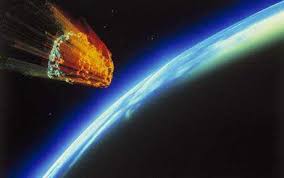The difference between meteors and meteorites is in the format. Dust and debris are meteoroids. They regularly come into the atmosphere, where they completely burn. These flashes of light at about 100 km altitude at an enormous rate of tens of kilometers per second are called meteors or shooting (or falling) stars.
Larger debris survive sometimes (partly) the fiery descent through the atmosphere, and munch on the earth's surface. This is called a meteorite.
Meteors can be seen individually, but also in meteor showers (e.g. the Perseids and Leonids).
 If you see a shooting star you can make a wish. Otherwise too, of course. Go ahead..
If you see a shooting star you can make a wish. Otherwise too, of course. Go ahead..
Comets are small bodies of ice, dust and gas ('dirty snowballs') that normally run in elliptical orbits around a star. If they are close enough to a star they sublimate (evaporate) partly so that a coma (on atmosphere) and / or a comet tail can be seen.
This gas cloud (coma) may be 100,000-1,000,000 kilometers, and one or more tails can be up to more than 150 million kilometers long.
The solid part of the comet, the comet nucleus is up to 50 kilometers.
The orbital period around the star can be up to several thousands of years.
The most famous is comet of Halley. This British astronomer calculated for the first time its orbital period of 76 years.
As one of the possible explanations for the Christmas star of Bethlehem (Gospel of Matthew) is often suggested that it was a comet.
Planetoid is the European term for an asteroid: a relatively small, irregularly shaped celestial body that orbits like a planet around the sun.
There are more than 300,000 known. Most have orbits between the planets Mars and Jupiter. The largest are nearly 1,000 miles, but the majority is small as dust.
Public attention to the risk of impacts of meteorites came from the work of Eugene Shoemaker, who in 1960 showed that they have played a major role in the formation of craters on the Earth, Moon and other planets.
Asteroids that come close to the earth and have the chance of a collision are called Near Earth Objects.
The mass extinction of animal species including the dinosaurs is attributed to the impact of a medium-sized asteroid 65 million years ago.
The next asteroid that poses as a threat, it is possible Apophis which will be approached on April 13, 2036 at 37 to 38,000 kilometers from the earth and a probability of 1 in 45,000 has to hit the planet actually according to Russian Professor Leonid Sokolov of state University of St. Petersburg. Seven years later, a collision can follow. A desert size of France may be the result. Probably Apophis, which has a diameter of about 350 meters, will the coming years fall apart into smaller pieces.
In October 2008, from Arizona (United States) for the first time a suspected 'impact' of a newly discovered small asteroid (2008 TC3) was reported. She was the size of a car and would above northern Sudan explode in the atmosphere with a kinetic energy equivalent of 1,000 or 2,000 tonnes of TNT. Some Meteo satellites recorded and confirmed the event.
A heavy impact can not only cause great local damage, but even totally change the environment, by large-scale forest fires, “impact winter“ effects by the huge dust emissions into the atmosphere, Tunami 's...
In 1908, the impact of an asteroid in Tunguska Russia) smashed 2,000 square kilometers of Siberian forest to the ground. The explosion let a power of 10 megatons of TNT free. Such an impact would may occur around 1,000 years to 300 years.
The book “The Jupiter effect“ was a bestseller in 1974. It was accurately described how on March 10, 1982 the world would end because all the planets would be aligned.
Recently it was claimed on the Internet that Comet Elenin could distort the Earth's axis in October 2011 and would provide an unprecedented flood.
Each time something with the timing, or the effect goes wrong.
Help, the end of... a leftover comet is near
(To an article from October 2011)
Comet Elenin was discovered by Russian Leonid Elenin (only) in December 2010.
On October 16 shaves (a remnant of) the comet at 35.4 million miles away along our Earth. According to NASA there is no reason to panic. According doomsayers it is possible already the end of the world.
On the internet it’s buzzing of course of apocalyptic rumors and conspiracy theories, 2012 is approaching.
By a huge storm on the Sun in August and one in cosmic terms 'immediate passage’ of the Sun, the comet began to disintegrate. The remaining debris will whiz over us only to return within 12,000 years again. The remains will be barely visible say experts include NASA. So there is nothing to worry about.
According to astronomer Don Yeomans of NASA Elenin has never even been a threat to our planet.
And one day after Elenin is already asteroid 2009 TM8 to come by. This lump of stone the size of a bus is hurtling us just inside the orbit of the Moon. But again without any danger.
